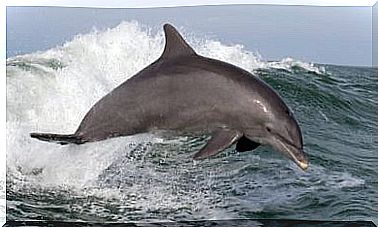Medusa Flower Hat: Is It Dangerous?

Cnidarians arouse mixed emotions in most people: many of them look mysterious and fascinating, but you don’t want to look too closely at them either. The flower hat jellyfish is no exception: its incredible shape inevitably attracts the eye, but many wonder if it is dangerous.
If you want to know more about this little swimming jelly, here is everything you need to know about it. With its neon tentacles and its alien form it is sure to conquer you.
Characteristics of the medusa flower hat
The flower hat jellyfish ( Olindias formosa ) is an invertebrate of the cnidarians family that lives in the waters of Japan, Brazil and Argentina, usually in coastal areas where marine algae abound. They are nocturnal animals, since they take advantage of the darkness of the night to go hunting small fish that inhabit the seabed.
These animals can measure up to 15 centimeters and their life expectancy is about 6 months. They have about 300 tentacles – although only 15 of them are food – ending in a small bioluminescent bulge. Being nocturnal, studies claim that this light emission helps the jellyfish attract prey.

The reproduction of the flower hat jellyfish, a mystery
Jellyfish reproduce alternately , like most cnidarians. This means that they alternate sexual and asexual reproduction to ensure a good number of offspring and genetic variability. However, until recently, the life cycle of this jellyfish was not fully known, as it was impossible to breed it in captivity.
Cambridge University studies bring us the answer. Its maturation cycle is as follows:
- Adult jellyfish: through sexual reproduction, this cnidarian releases microscopic gametes and eggs into the surrounding water, where fertilization with the genetic material of other jellyfish occurs. The offspring produced in this interaction are not copies of their father or mother, but a combination of both.
- Planules or larvae, which hatch from the eggs and adhere to a hard surface.
- Polyps: asexual reproduction occurs at this stage, as polyps proliferate and the juvenile jellyfish will be born from them. Interestingly, the polyps of the flower hat jellyfish have only one tentacle, albeit a very active one. The offspring produced at this stage will be genetically the same as its predecessor.
- Juvenile jellyfish: at this stage, the jellyfish will develop to its adult size – at this time it is only about 2 millimeters long – thus closing the reproductive cycle.
Some curiosities about this jellyfish
The flower hat jellyfish has a unique adaptation: when food is scarce, it is able to reduce its body size. In this way, the need for ingestion decreases and its chances of survival increase.
Furthermore, this invertebrate lacks a head, brain, heart, bones, cartilage, or eyes. Your body is composed almost only of water, specifically 95%. Its somatic sensitivity is carried out by cells specialized in detecting physical stimuli around it.
Its bioluminescence, produced by proteins present at the ends of its tentacles, is also observed in the polyp stage. In this period, the polyp uses its single tentacle to sweep its surroundings in search of nutrients, a process that also seems to be favored by the light it emits.
Flower hat jellyfish: is it dangerous?
If you’re worried about running into one of these invertebrates and having a fatal accident, fear not: it doesn’t have enough venom to kill you. Since it preys on small fish, its toxins are powerful enough to kill them almost instantly, but not enough for an adult human.
The sting is painful and looks like a burn. It can be treated by conventional methods: apply saline or saline water and go to the aid station. The area should not be scratched or rubbed, otherwise the toxins penetrate further into the skin.
Conclusions: state of conservation and coexistence with humans
As it is a rare species of jellyfish that inhabits small geographic spaces, there are several conservation projects for the flower hat jellyfish. However, it is not considered to be in danger of extinction.
The biggest problems experienced by human populations living on the coasts where this jellyfish inhabits are the bites of swimmers and divers. They have also been reported to obstruct fishing nets or water inlets in hydroelectric dams.
However, jellyfish fulfill their true role in nature in an effective way, controlling fish populations. In addition, its biofluorescence is being studied, in order to expand the knowledge about mimicry.

In short, the flower hat jellyfish is one more link in maintaining the balance of the ecosystems in which it inhabits. Although it is true that it can threaten certain economic activities, such as tourism or fishing, it is only in our power to create a positive coexistence with the rest of the species that populate the planet.









